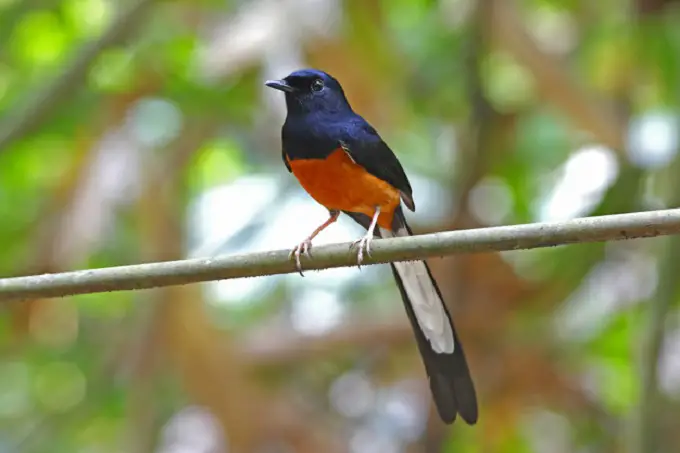White-rumped shama, scientific name Copsychus malabaricus, is a species of bird in the passerine family with bright colors and melodious songs, making them one of the most popular birds in the world.

Outstanding Features
The fire warbler stands out with its multicolored plumage, most of its body is glossy black, dotted by a long tail with white underparts and white back. In particular, they have dark brown wings and a clear white stripe on the lower back, adding beauty to the plumage. Males and females have similar plumage, but females are usually smaller and less brightly colored.
Living and Environment
The warbler is widely distributed in South and Southeast Asia, from India, Sri Lanka, through Southeast Asian countries such as Thailand, Malaysia, and Indonesia. They prefer natural habitats such as dense forests, humid tropical forests, and forest edges with dense shrubs. However, they can also be found in gardens and parks in urban areas.
Diet
The diet of the warbler is quite diverse, mainly consisting of insects such as cockroaches, insects and spiders. In addition, they also eat small fruits, seeds and nectar, showing flexibility in finding food.

Reproduction
The breeding season of fire warblers usually starts from March to July. They build nests in crevices of trees, usually underground. Each clutch usually has 2-4 eggs, and both parents are involved in incubating and raising the young.
Singing Sound
The warbler’s song is one of its most outstanding features, with a complex, melodious melody and the ability to imitate the sounds of other birds and noises from the surrounding environment. This makes them a popular ornamental bird, especially in Asian countries.
Conservation and Threats
Although the warbler has a wide distribution range and stable populations in some areas, they are facing risks due to loss of natural habitat and commercial hunting as ornamental birds. Conservation efforts are underway to protect this bird, including establishing sanctuaries and curbing illegal trade.
The warbler is not only a symbol of natural beauty but also a testament to the ecological value that this bird brings. Conservation of the fire warbler not only helps maintain biodiversity but also contributes to maintaining the balance of the tropical forest ecosystem.

